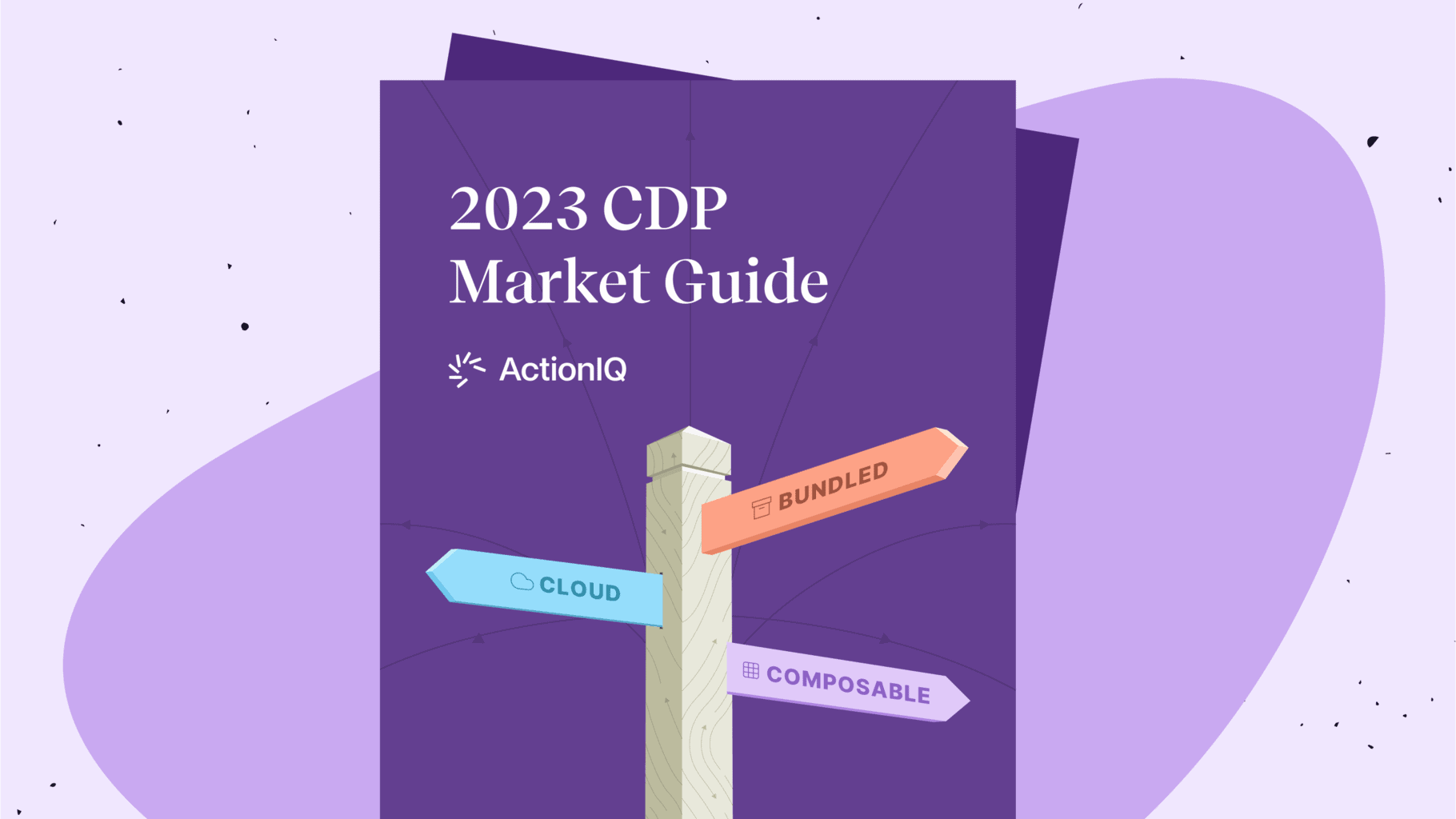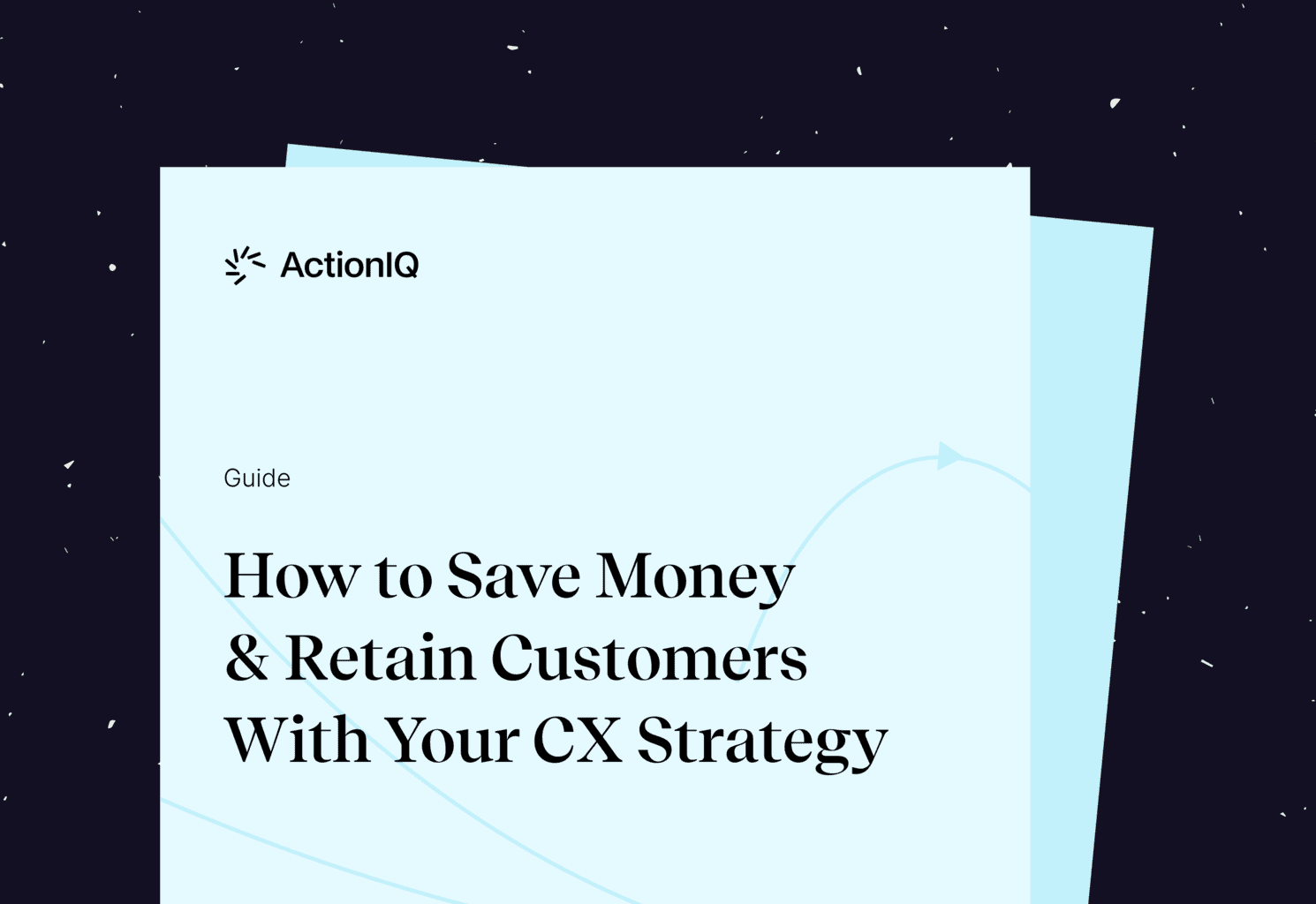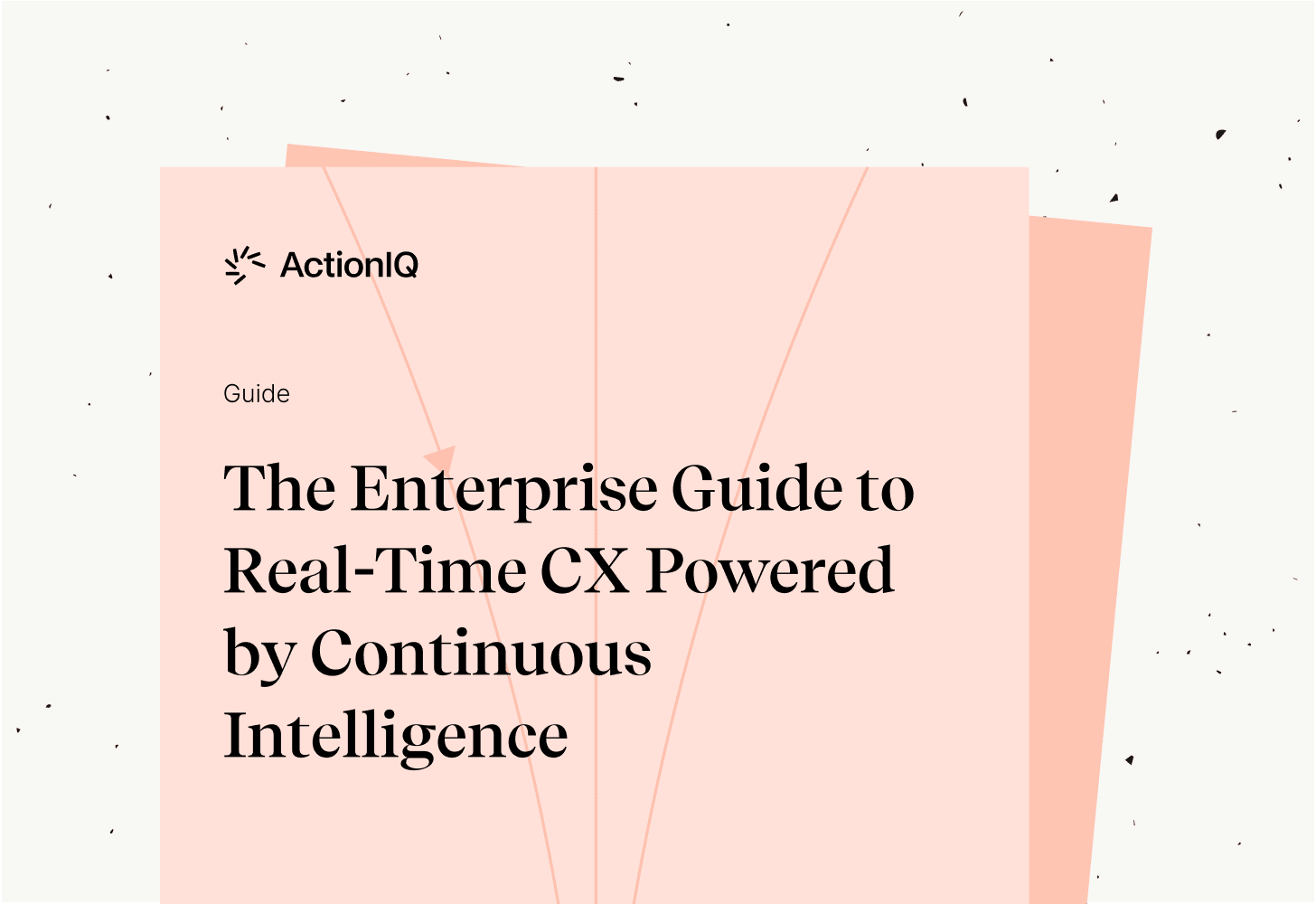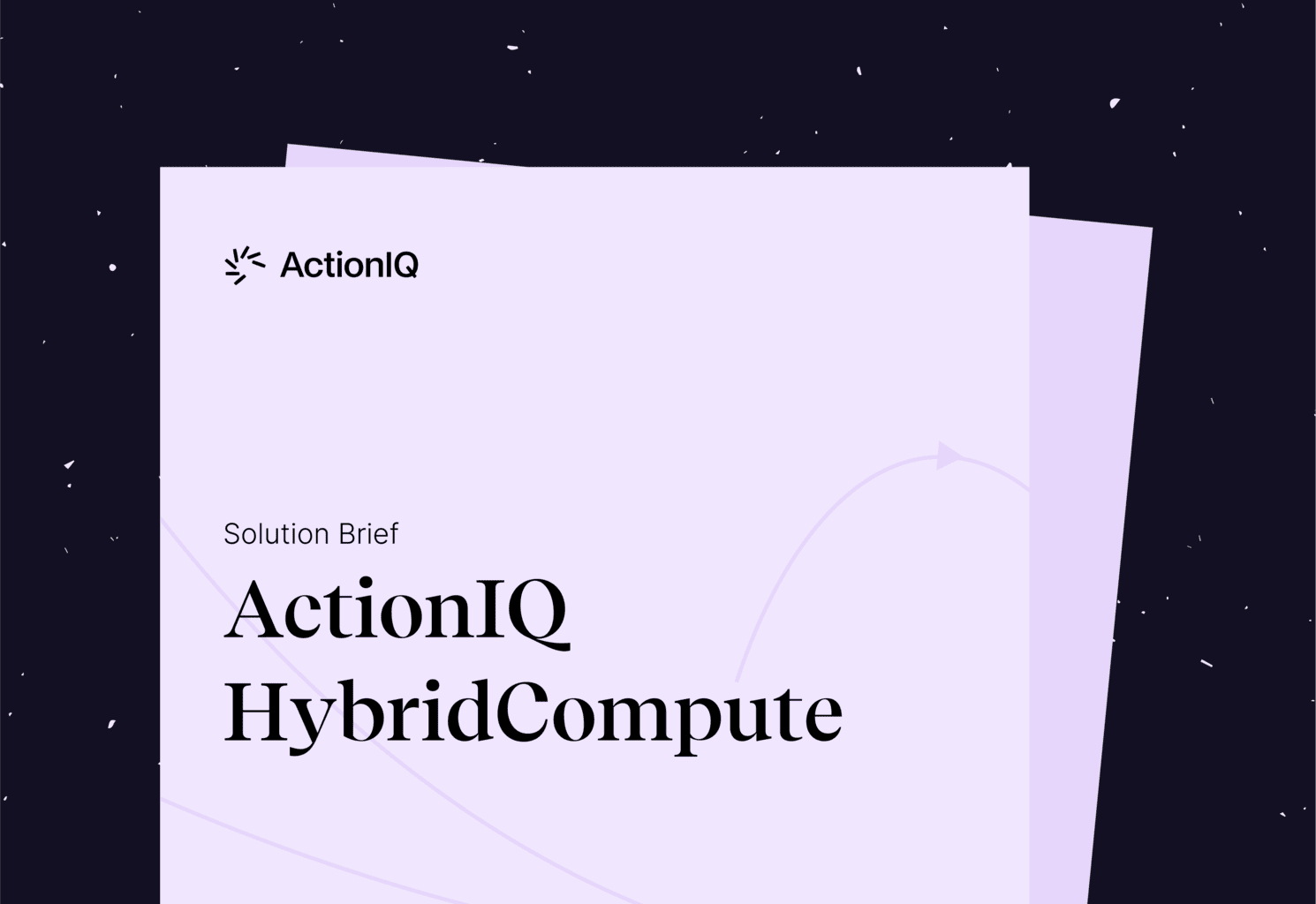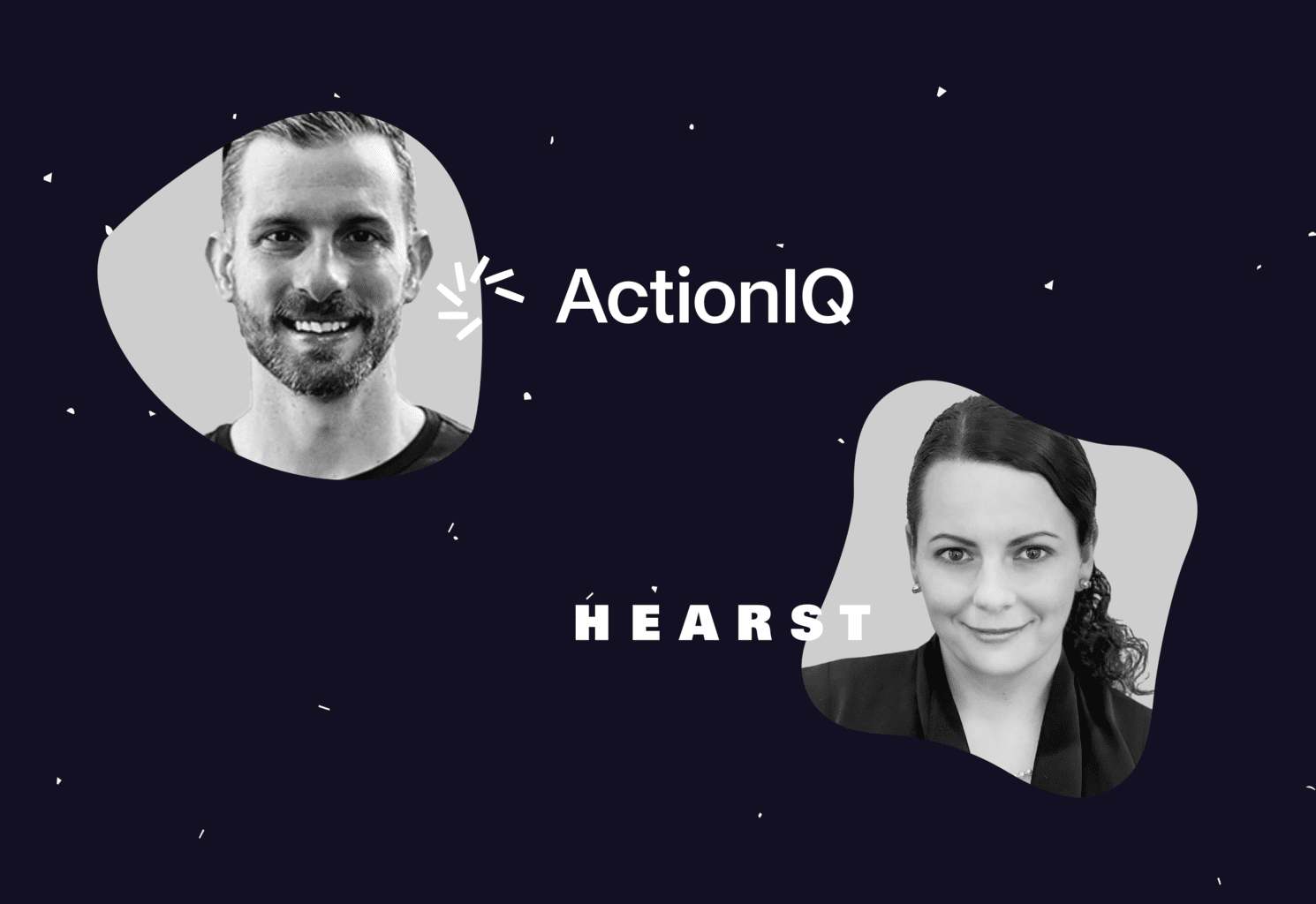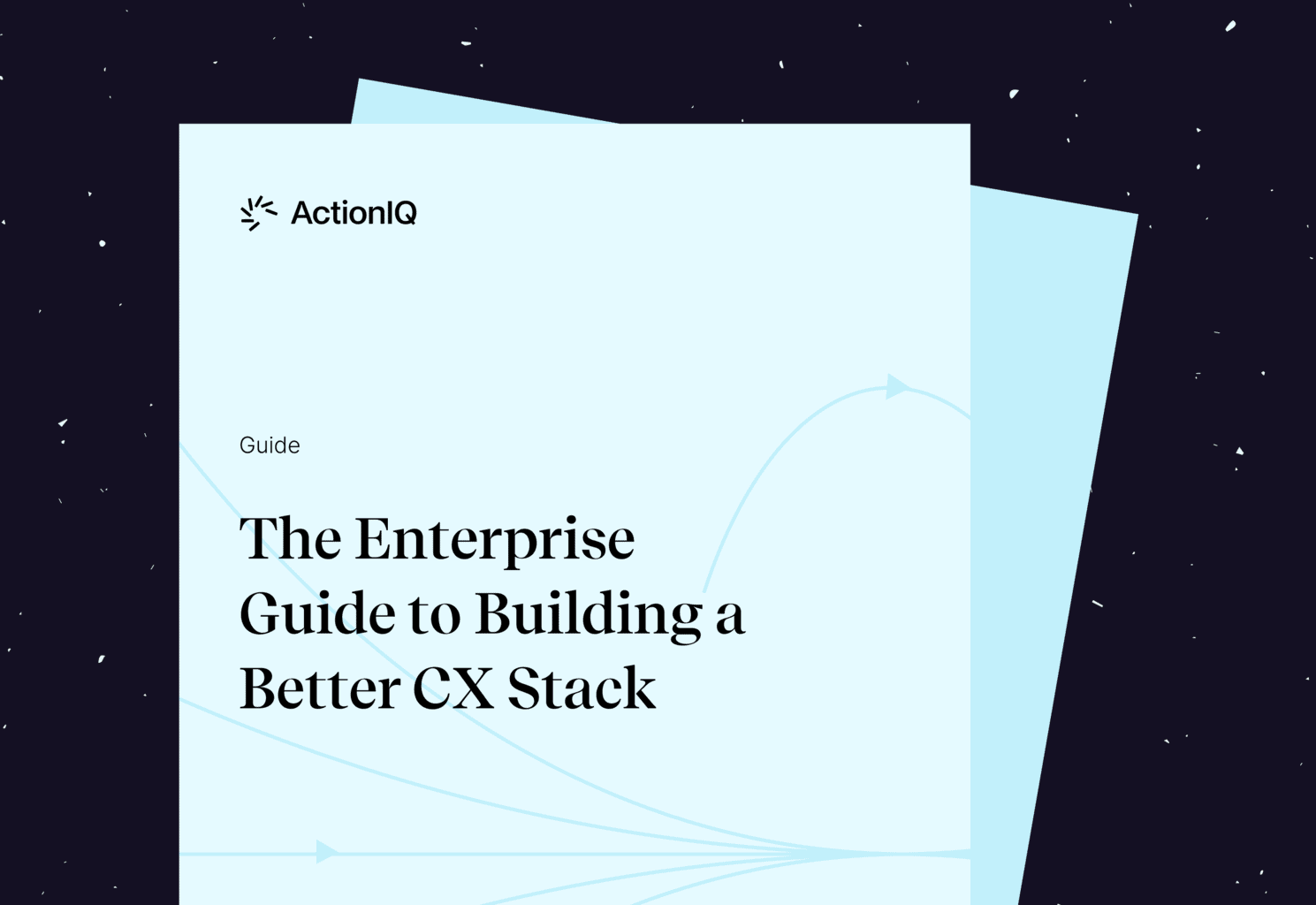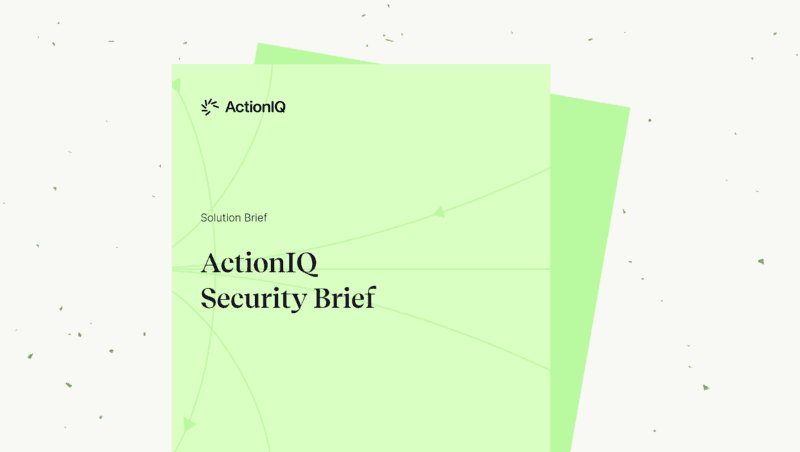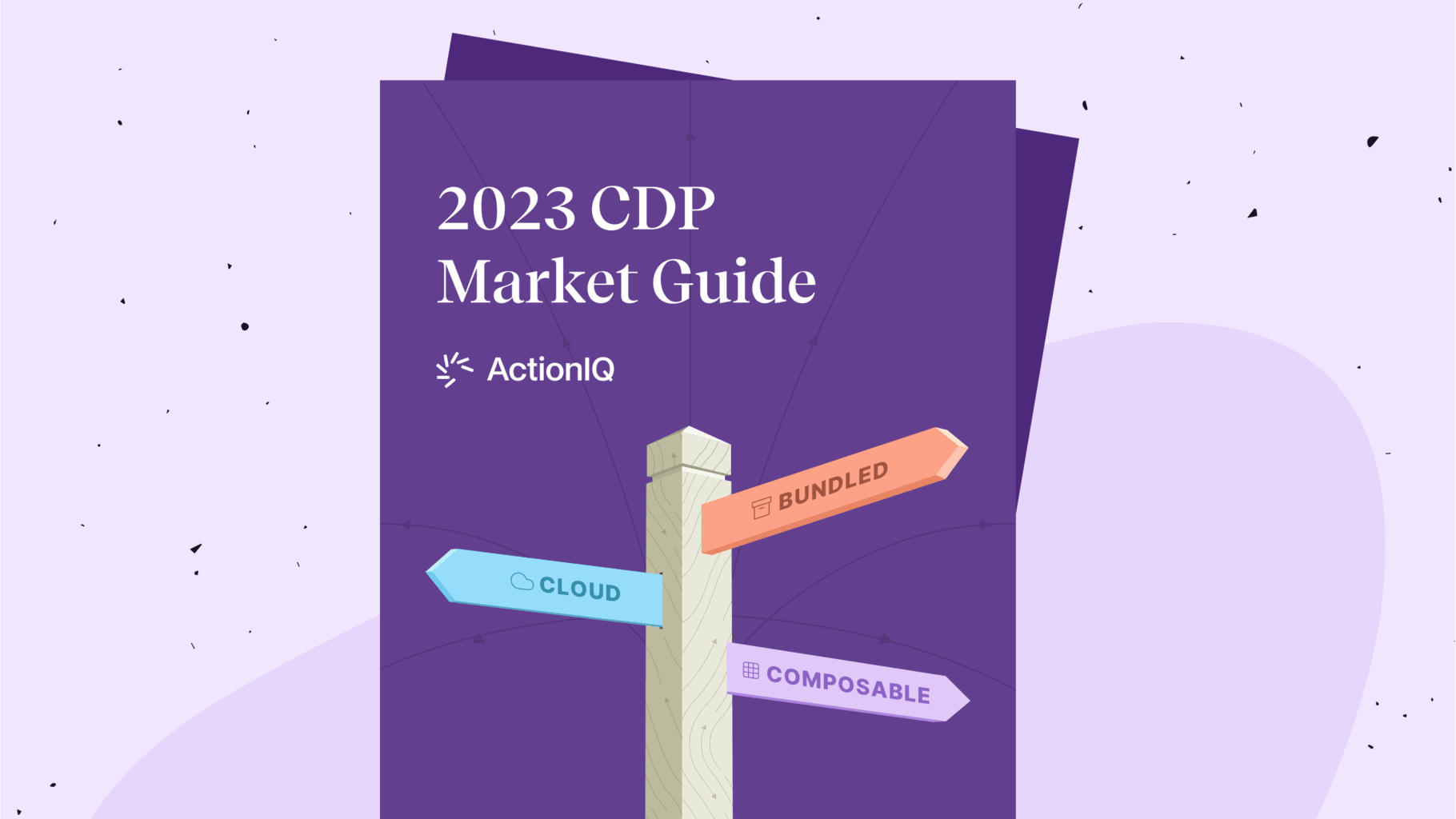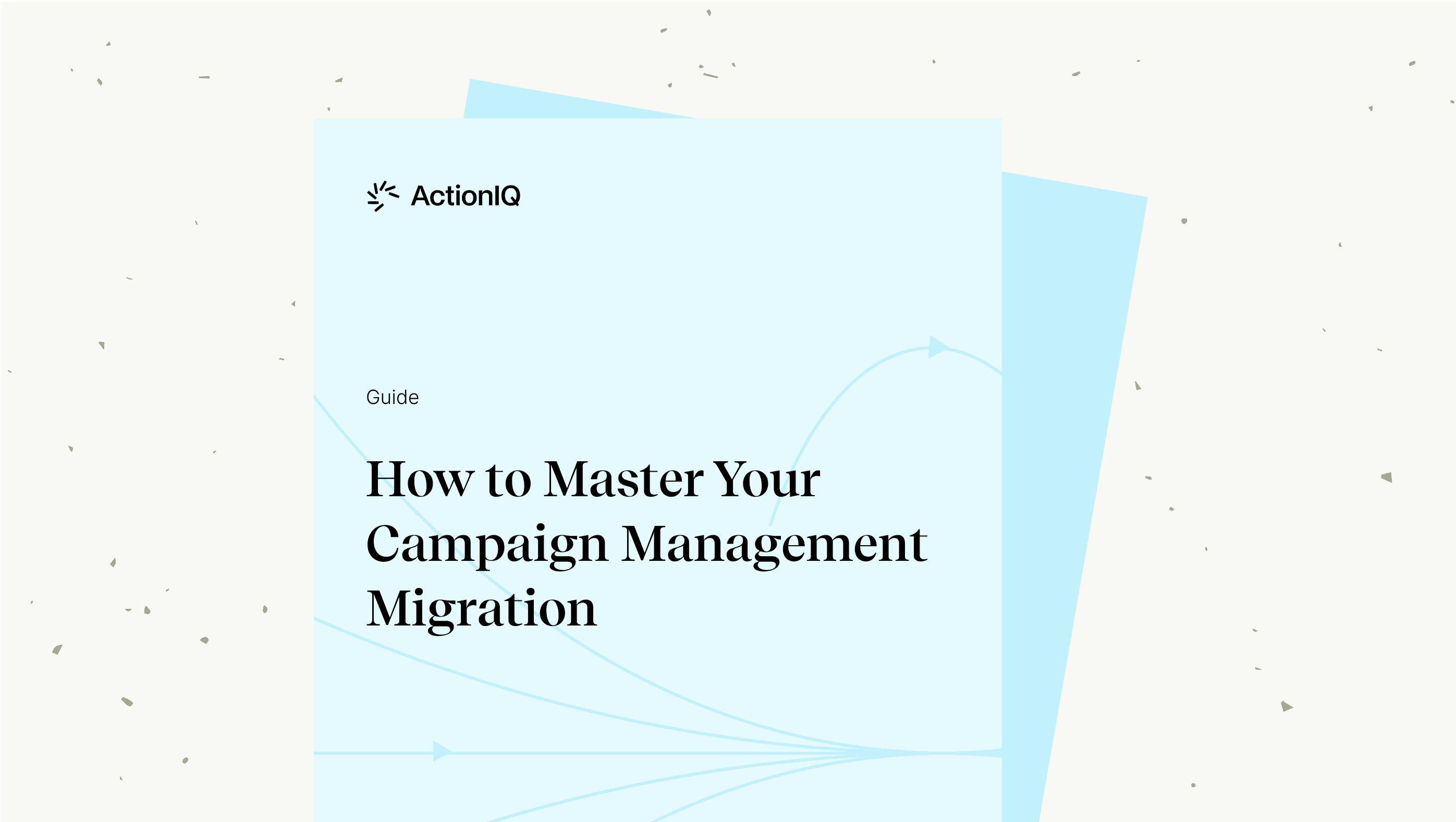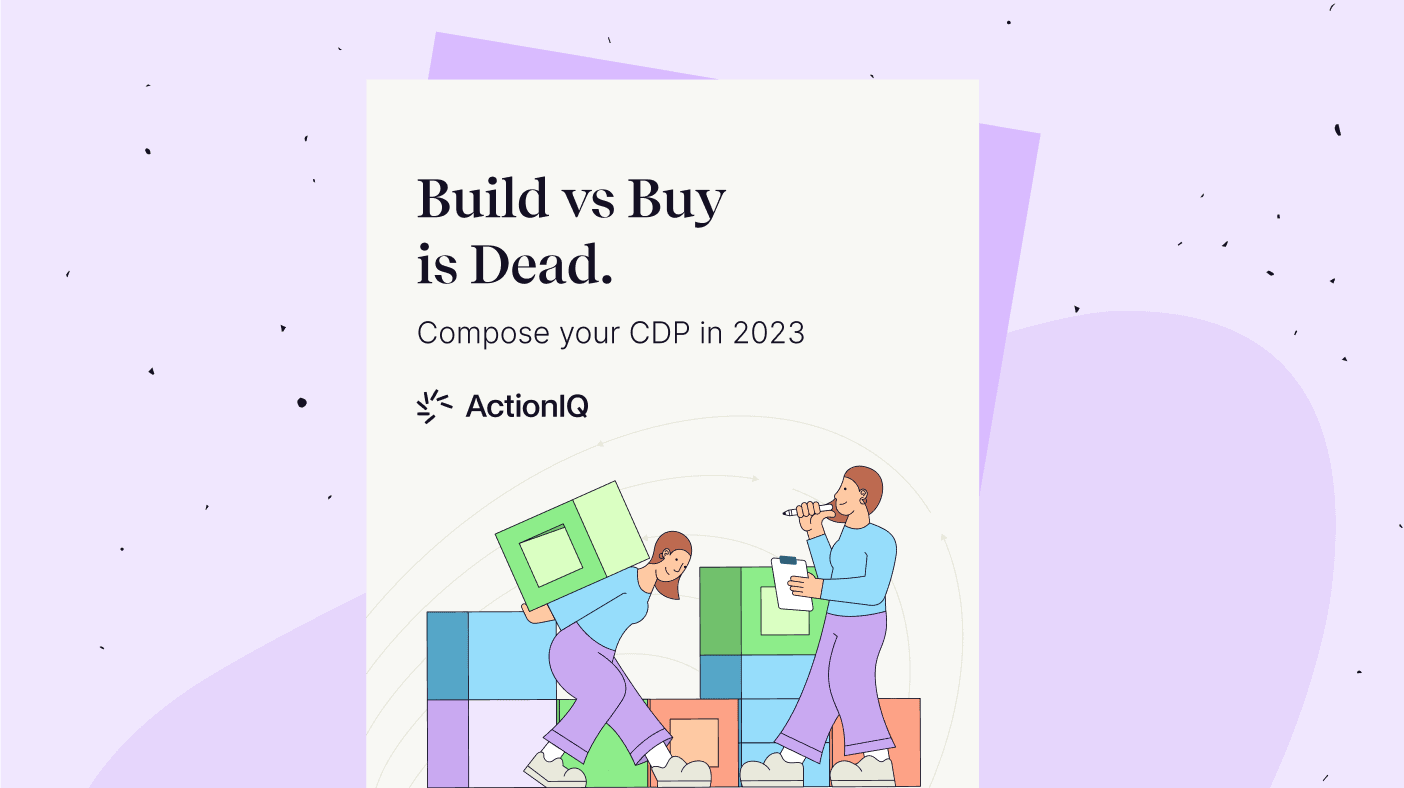What is a Customer Data Platform (CDP)?
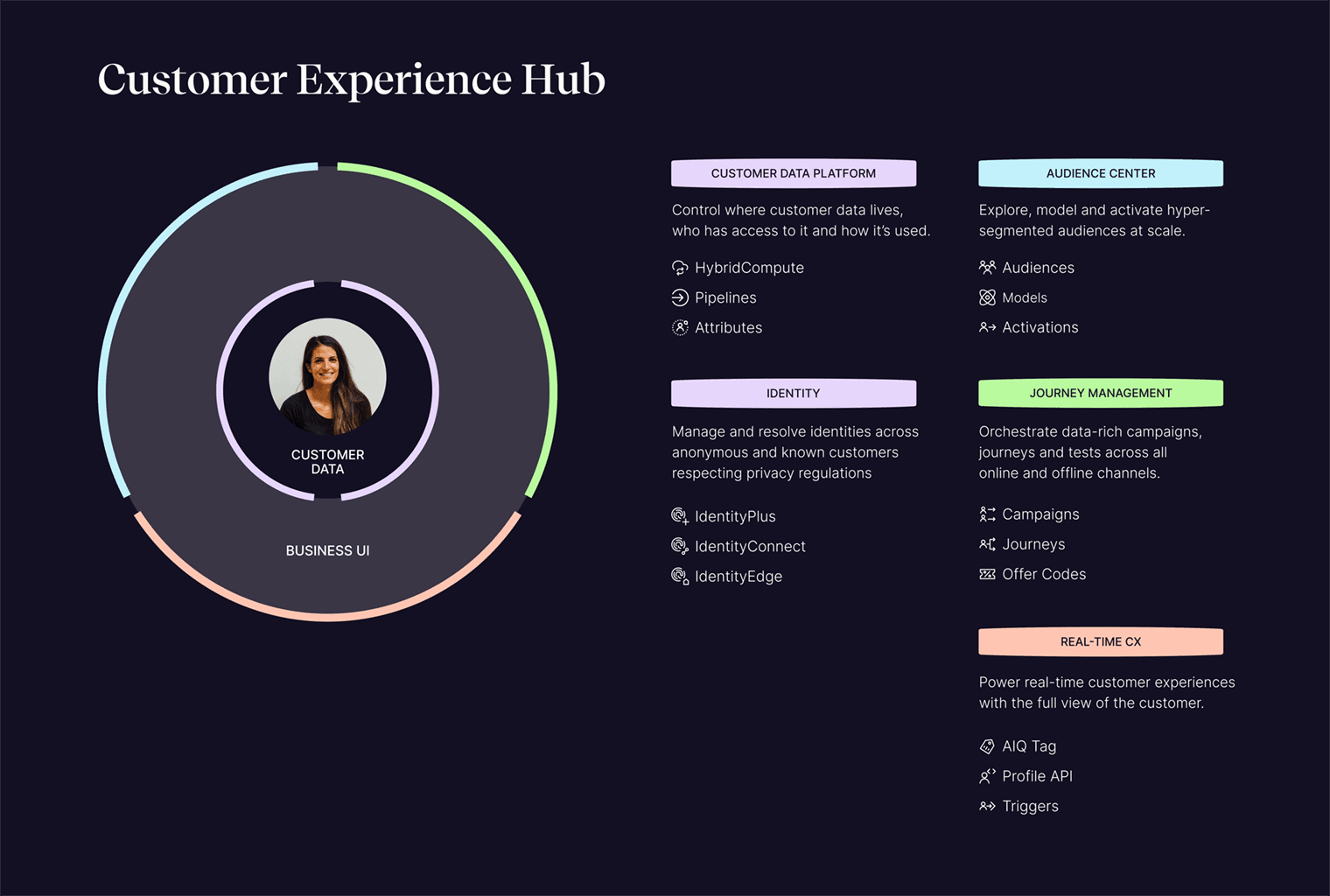
The customer data platform (CDP) market can be confusing. It’s all too easy to get lost in a sea of technical jargon.
And while it’s important to focus on the features and functionalities that will help your enterprise business provide superior customer experience (CX), remember that at the end of the day, CDPs are built to help business teams resolve the bottlenecks and technical challenges that prevent them from becoming self-serving and customer-centric.
CDPs are designed for the marketers, salespeople, customer service representatives and other non-technical business users who drive customer experience. They help these CX professionals better understand customers and deliver personalized experiences at scale across all online and offline channels.
This empowers business teams to ensure all customer engagement is highly relevant and impactful while reducing the burden on information technology and data analytics professionals.
CDPs do this in three ways:
1. Customer 360
CDPs collect customer data from first-, second- and third-party sources through prebuilt, real-time data connectors. This data — including information related to customer identities and interactions — is then stitched together into a single, persistent profile of each customer.
2. Customer Intelligence
CDPs make customer insights accessible via a user-friendly interface that allows users to analyze customers, segment audiences, predict behaviors, determine next-best actions and identify trends.
3. Customer Experiences
CDPs enable automated orchestration of personalized, real-time customer experiences across all marketing, sales and customer service channels in the form of multi-step customer journeys and triggered or scheduled events. Users can design journeys, monitor experiences, A/B test variations, utilize control groups, report on performance and much more to optimize CX over time.
Want to learn more about the ins and outs of customer data platforms? Dive into the information below to answer all your CDP questions.
What is a Customer Data Platform or CDP?
As a marketer or businessperson, you may have heard the term CDP a lot; however, not a lot of people actually understand what the acronym means. So what is CDP? Customer data analytics are revolutionizing the business world. A customer data platform (CDP) is a prebuilt technology used by marketers and customer experience professionals to understand their organization's customers and scale personalized experiences across marketing, sales, and service channels.
Enterprise businesses have lots of customer data. Business teams need to be able to access, analyze and activate that data in order to provide personalized customer experiences.
Unfortunately, this is easier said than done.
Customer data is often fragmented and siloed across multiple systems. And even if it's unified, non-technical teams will find it difficult to get what they need, make sense of it and use it to create tailored experiences without either learning programming language or relying on IT and data science teams for help.
In short, enterprise companies need technology that:
-
- Unifies all customer data
-
- Provides an easy-to-use interface for managing data
-
- Generates predictive insights
-
- Orchestrates seamless experiences across all marketing, sales and customer service channels
This technology is called a customer data platform or CDP.
Watch our video below on Customer Data Platforms (CDP) 101:
4 Critical Capabilities of a CDP
To help enterprise businesses assemble, analyze and activate their customer data, a CDP requires four capabilities:
1. Creating a 360-Degree Customer View
A CDP should unify and match all profiles and interactions across online and offline channels to create a single customer view. This means ingesting, cleansing and storing all customer data from all digital and non-digital data sources, as well as resolving, authenticating and deduplicating customer records via configurable, deterministic and probabilistic matching.
2. Displaying Customer Analytics
A CDP should provide customer insights and augment them with artificial intelligence to model and predict customer behavior. This means analyzing audiences for segmentation and targeting, as well as performing advanced analytics and operationalizing machine learning-based models across the entire history of customer behaviors.
3. Orchestrating Customer Experiences
A CDP should support the orchestration, testing and measurement of experiences across all customer touchpoints. This means orchestrating ad-hoc, triggered or journey-based experiences from a single user interface to all marketing, sales and customer service channels in real time, as well as configuring tests across any channel and measuring performance using customizable business metrics or machine learning algorithms that automate experience optimization.
4. Enabling Non-Technical Users With a Business-Friendly User Interface
A CDP should enable all business users - not just IT and data science teams - to explore and take action on customer insights. This means democratizing data with an intuitive user interface that doesn't require advanced technical knowledge and empowering users to self-serve insights, as well as ensuring privacy and security with defined permissions and governance controls.
"ActionIQ has become the central hub for creating personalized brand experiences delivered in real time across our digital and offline channels to empower business users."
Vice President of Data and Platforms, $5B+ Retailer
3 Key Benefits of a CDP
Enterprise CDPs have many benefits, but they can generally be categorized in one of three ways:
1. Enhancing and Expanding Revenue Streams
CDPs provide organizations with the customer insights they need to capitalize on growth opportunities and increase speed to market. This could include driving more revenue by optimizing customer acquisition or increasing customer lifetime value (CLTV), as well as cutting marketing costs via improved audience targeting and shortened conversion times.
2. Increasing Operational Efficiency
CDPs provide organizations with the tools they need to increase team productivity and streamline processes. This could include enabling business teams to self-serve insights so technical teams can focus on higher-value projects, updating a marketing technology stack to eliminate redundancies and optimize spending, as well as providing teams with greater agility for strategy iteration.
3. Improving Customer Experience
CDPs provide organizations with the capabilities they need to gain greater visibility into their customers across channels and deliver compelling CX at the right time and place. This could include reducing churn by identifying and engaging at-risk customers, personalizing experiences to build brand loyalty and optimizing omnichannel engagement to increase customer satisfaction.
Watch our video below on CDP Benefits & Cost of Doing Nothing:
What Types of CDPs Are There?
CDPs have become a must-have technology for enterprise brands. The CDP market is crowded with vendors trying to capitalize on demand. But it's important to remember that not all CDPs have the same capabilities.
While every CDP should have some capacity for unifying, analyzing and activating customer data, different types of CDPs have certain specializations
-
- Marketing cloud CDPs: Marketing cloud CDPs, such as those offered by Adobe, Salesforce and Oracle, were built to compile data from point solutions within their own cloud portfolios to create a single view of the customer.
-
- Data integration CDPs: Data integration CDPs, such as those offered by Segment, Tealium and mParticle, were built to collect event data from digital applications and transmit it to other apps in real time to facilitate system integration and enable triggered communications.
-
- Identity management CDPs: Identity management CDPs, such as those offered by Amperity, were built to collect, match and manage customer profiles from online and offline channels to deduplicate customer records and create a customer 360.
-
- Data science CDPs: Data science CDPs, such as those offered by Treasure Data, Acquia and SAS, were built to create analytical models based on customer data to predict behavior.
-
- Website personalization CDPs: Website personalization CDPs, such as those offered by BlueConic and Lytics, were built to personalize and optimize content for website and mobile app visitors.
- Experience orchestration CDPs: Experience orchestration CDPs, such as those offered by ActionIQ and Redpoint Global, were built to scale personalized experiences across all online and offline touchpoints using customers' full profile histories.
Navigate the Evolving CDP Market With Ease
2024 CDP Market Guide
What a CDP Isn't
With their focus on customer data and personalizing customer experiences, CDPs are sometimes confused with other technologies. Some of the most common examples are:
-
- Data lakes: Data lakes are used to store raw data. This can go well beyond customer data, including financial, product, store, service, transaction and human resources data. They're used by IT teams to support enterprise-wide analytics and data science. The data is only accessible via programming languages such as SQL, Python, R and Java.
-
- Enterprise data warehouses (EDW): EDWs are similar to data lakes, but they're used to store structured, filtered data that's already been processed for one use case or another. And like data lakes, they're built for and are only accessible by technical professionals, not everyday business users.
-
- Data management platforms (DMP): DMPs are used to tailor paid digital advertising to anonymous audiences on third-party websites, search platforms and social media networks. However, due to the deprecation of third-party cookies, DMPs are being phased out in favor of technologies that prioritize first-party data, such as CDPs. Check out our CDP vs. DMP article to learn more.
-
- Master data management (MDM) systems: MDMs are used to resolve customer identities and create a golden record of individual customers using personally identifiable information (PII). While CDPs can also be used for identity resolution, they're not intended to be used as identity systems of record for enterprise companies. MDMs are used by IT and customer support teams to create a master ID, which can then be used as an input for a CDP.
- Customer relationship management (CRM) tools: CRMs are used to store customer interaction data, such as questions, comments and complaints, as well as basic customer information (e.g., name, phone number, email address, etc.). They're used by sales and customer service teams for logging information. Again, this information can be used as an input for a CDP. Check out our CDP vs. CRM article to learn more.
Watch our video below on CDP vs MDM and Their Key Differences:
Why Use a CDP?
Customer Data Platforms are the next level of marketing technology and empower business users and analysts to leverage all available data and insights to make every customer engagement count. They consolidate data silos, create a 360-degree customer view, and democratize access to customer data for purposes of personalizing interactions across marketing, sales, and service channels. Ultimately, CDP data gives marketers and customer experience professionals the ability to provide a real-time personalized experience to customers by consolidating data silos and creating authentic customer interactions.
Customer experience is essential to acquiring, retaining and building long-lasting relationships with customers. Personalization is the foundation of exceptional CX - and impossible to achieve without customer data.
Unfortunately, the complex and siloed nature of customer data presents many obstacles for enterprise organizations.
-
- Business teams: Without access to unified customer data, business teams struggle to understand their customers, segment audiences and activate personalized experiences. They can't innovate new campaigns or initiatives, or execute on existing ones quickly and confidently.
-
- IT teams: With a lack of integrations with other tools - as well as constant requests related to customer data management from business and data teams - IT teams struggle to find the time for higher-impact projects and minimize operational costs. They can't keep up with ad hoc requests or satisfy business stakeholders.
-
- Data teams: With incomplete, disconnected customer identities - and endless requests from business teams related to audience segmentation - data teams struggle to develop accurate predictive models and deliver on other business-critical priorities. They can't gain full access to unified customer profiles or effectively operationalize models in the market.
These and other issues cause problems for executive teams, which struggle against growing technology costs, operational inefficiencies and an inability to achieve business goals.
The result is:
-
- Delays
-
- Missed market opportunities
-
- Wasted time and effort
-
- Increased expenses
-
- Cross-functional friction
-
- Disjointed customer experiences
-
- Unsatisfactory customer service
-
- Competitive risk
CDPs resolve these common pain points, enabling enterprise companies to ensure their customer data is accurate, accessible and actionable. This makes it possible for business teams to provide the right customers with tailored, highly relevant experiences at the right time and place while reducing burdens on technical teams.
"We have a focus to provide an excellent experience for customers — and that's where a CDP comes in."
Daren Hull, Chief Customer Officer, Vera Bradley
What is the ROI of a CDP?
The return on investment of a CDP is both quantitative and qualitative.
For example, based on a Forrester Total Economic Impact™ (TEI) report commissioned by ActionIQ, enterprise brands that invest in the ActionIQ CDP achieve:
Revenue Growth
This includes:
-
- 80% increase in conversion rates
-
- 20% increase in average purchase value
-
- 7% increase in return on advertising spend (ROAS)
Cost Savings
This includes:
-
- $1.6 million decrease in costs related to legacy technology and services
Efficiency Gains
This includes:
-
- 40% increase in data analyst efficiency
-
- 25% increase in marketer efficiency
Additionally, the same report found that ActionIQ customers can expect increased:
-
- Agility and speed to innovation for marketing and other CX professionals
-
- Scalability and a wider variety of data-driven business use cases
-
- Technology flexibility to support a best-of-breed martech strategy
Recommended Guide
How to Save Money & Retain Customers With Your CX Strategy
What is Customer Data?
Below are the types of customer data often managed by a customer data platform (CDP):
-
- PII info: Personal customer information such as name, address, phone, email, etc. (oppositely for anonymous users, CDPs will store device ID or cookie ID)
-
- Campaign and customer engagement info: Data reflecting the campaigns a customer received, the engagement within them, and other interaction data across marketing, advertising, sales, and support channels
-
- Transaction info: Examples include products purchased, channels transacted through, purchase prices, discounts used
-
- Metrics and scores: Examples include customer health scores, average click rates, customer loyalty status, lifetime value
-
- Demographic or firmographic info: Examples include dwelling type, estimated income, company type, company industry, number of employees
-
- CSAT data: Examples include satisfaction scores from surveys and interactions with customer support associates
Recommended Webinar
How to Build a Resilient Data Strategy With Composable CDPs
Why is Customer Data Important?
Wondering why you should care about customer data? There are four main reasons to prioritize it:
1. Consumers Have High Expectations
Consumer expectations regarding customer experience continue to rise. CX leaders such as Amazon and Netflix have ushered in a world where individuals expect brands to provide the most personalized, relevant experiences possible at all times. This can only be accomplished with customer data.
2. Engagement Channels Continue to Proliferate
Consumers not only demand exceptional customer experiences, they demand them across a wide range of both online and offline channels. To provide consistent CX across all channels - including websites, apps, email, social media, call centers, brick-and-mortar stores and more - brands must have full visibility into customer behaviors and preferences throughout the entire buyer journey.
3. Marketing is Expensive
With such high expectations to meet - and numerous channels on which to meet them - organizations must invest significant resources into captivating and converting consumers. But without data to understand which channels deliver the highest ROI - or prevent the wrong individuals from receiving outreach - brands will face unnecessarily high customer acquisition costs.
4. Third-Party Cookies Are Going Away
In the past, brands were able to rely on anonymous third-party cookies to assist with consumer identification and targeting. But third-party cookies are being eliminated, meaning enterprise companies must invest in first-party data to deliver the CX consumers have come to expect - or be forced to rely on expensive walled gardens and fall behind their competitors.
Recommended Guide
12 Acquisition Strategies for Watching the Cookie Sunset
How Do CDPs Leverage Artificial Intelligence (AI), Machine Learning (ML) and Other Predictive Analytics?
CDPs do most (or all) of the hard work of preparing data for predictive analytics by gathering raw, disparate customer data and combining it into a single customer view. From there, users can instantly apply prebuilt predictive algorithms to their data.
CDPs enable predictive analytics in four ways:
1. Algorithmic Identity Resolution
Enterprise brands can deduplicate customer profiles using machine learning-powered deterministic and probabilistic matching techniques.
2. Prebuilt Analytic Models
Enterprise brands can use a library of native, machine learning-powered models to quickly forecast the likelihood of customer churn, uncover ideal send times, create lookalike audiences and more.
3. Homemade Model Hosting
Enterprise brands can integrate model scores built in house into a machine learning framework for business-specific objectives, such as audience segmentation.
4. Algorithmic Performance Measurement
Enterprise brands can use algorithmic performance measurement that uses statistical methodologies to track the progress of campaigns and evaluate results.
Recommended Webinar
Is Your Marketing Stack Ready for Omnichannel CX?
How Do CDPs Enable Omnichannel Customer Experiences?
Exceptional CX depends on a brand's ability to deliver consistent experiences across all online and offline channels. CDPs facilitate omnichannel customer experiences in four ways:
1. Data-Driven Insights
CDPs collect customer interactions from all systems, enabling enterprise brands to understand and predict their customers' behaviors and preferences across different channels.
2. Data Democracy
CDPs ensure the business teams responsible for providing CX across different channels are kept up to date on customers' wants and needs via complete, accurate profiles.
3. Journey Design, Orchestration & Measurement
CDPs empower business teams to create sophisticated, multi-step customer journeys that can be fully automated and dynamically adjust channels, content and timing based on customer behaviors and preferences.
4. Cross-Channel Execution
CDPs combine hundreds of real-time data connectors to activate segmented audiences and customer journeys on final-mile execution tools across all marketing, sales and customer service channels.
Recommended Guide
The Enterprise Guide to Real-Time CX Powered by Continuous Intelligence
How Do CDPs Support Personalization at Scale?
Personalization is the cornerstone of superior CX, but delivering tailored, highly relevant experiences to millions of customers is easier said than done.
CDPs support personalization at scale in five ways:
1. Automated Data Unification
CDPs ingest data from every channel using prebuilt data connectors and automatically stitch it together into a persistent, single profile for each customer.
2. Data Accessibility
CDPs provide business teams with self-service access to accurate, unified customer insights for data analysis, data modeling and journey orchestration across all channels.
3. Predictive Analytics
CDPs use both out-of-the-box analytic models and hosted models to predict which products, offers, content, audiences and more will drive the best results.
4. Automated Syndication
CDPs leverage prebuilt, vendor-maintained data connectors to automate campaign execution across all channels.
5. Automated Measurement & Reporting
CDPs provide easy-to-use testing and measurement to automatically identify which campaigns, initiatives and customer journeys maximize desired business outcomes.
Recommended Brief
HybridCompute: Give Your IT Team Superpowers
What Are the Main Customer Data Platform Use Cases?
Customer data platform use cases can be divided into three categories based on the value they deliver to the business:
Incremental Revenue Generation
By providing meaningful insight into customer behaviors and preferences, CDPs enable marketers to discover net-new opportunities and act on them quickly.
Two common examples of incremental revenue generation via CDP are:
- Detecting at-risk customers and delivering automated messages to prevent churn
- Identifying premier prospects via lookalike models and targeting them via channels like direct mail, digital advertising, or social
Saving Marketing Costs
By calculating customer propensities via CDP marketing analytics, you can reduce marketing spend by targeting only customers with a high likelihood of conversion.
Two common examples of how to save marketing costs with a CDP are:
- Measuring discount sensitivity and minimize sending coupons to customers that don't display a need for them in order to buy
- Driving more efficient prospecting by suppressing existing customers from prospecting campaigns across paid media and direct mail channels
Increased Operational Efficiency
By automating data unification and empowering self-service operations, CDPs eliminate operational bottlenecks and reliance on expensive technical professionals.
Common examples of increased operational efficiency with a CDP include:
- Creating a single-source-of-truth for customer data where employees can gain accurate customer insights without fears of data inaccuracies
- Providing a user interface that enables scaled customer analytics, audience discovery, campaign list creation, campaign journey design, and campaign measurement
CDP Use Cases: 8 Common Examples
Curious how other enterprise companies are using their CDPs?
Here are 8 of the most common enterprise customer data platform use cases:
- Enhance customer acquisition: Use lookalike modeling to identify prospects who resemble your ideal customers. Target them across the channels (e.g., direct mail, digital advertising, social media, etc.) shown to drive the best results for these audiences.
- Shorten conversion times: Use customer interaction and purchase data to understand which channels, communications and products resonate most with customers. Inform content creation and customer journey orchestration with this information to speed up buying cycles.
- Personalize omnichannel customer experiences: Use both streaming and historical data to develop customized, highly relevant customer experiences. Create multi-step customer journeys - as well as triggered and scheduled real-time experiences - that are tailored to customers' behaviors and preferences across all online and offline channels.
- Increase customer retention and loyalty: Use lookalike modeling to identify customers who resemble your churned customers. Automate communications designed to re-engage at-risk customers and build brand loyalty.
- Optimize advertising spend with your CDP: Use customer data to suppress specific audiences from unnecessary paid advertising campaigns. Measure sensitivity to discounts among different segments to avoid wasting promotions on customers who don't wait for discounts or special offers to make a purchase.
- Eliminate waste: Use customer data to determine which channels - and the frequency of engagement on those channels - drive the best results. Prioritize high-value channels and refine the cadence of customer outreach using insights from your customer data platform.
- Centralize customer intelligence: Use a single source of truth to help teams across marketing, sales and customer service access the full customer profile. Increase cross-team visibility to identify and take action on opportunities without advanced technical knowledge or assistance.
- Increase speed to market: Use a business-friendly user interface to empower business teams to adjust data definitions and formats without having to submit requests to IT. Test and measure campaigns to optimize performance and innovate new strategies without having to wait for technical assistance.
Recommended Webinar
How Hearst Harnesses First-Party Data For Customer Acquisition & Conversion
How Do I Build a Business Case for a CDP?
Customer data platforms provide significant benefits to all parts of an organization, including marketing, IT, analytics and more. Every team plays an important role in successfully implementing and maximizing the value of a CDP.
This makes buy-in from all business stakeholders essential. It's important to position a CDP as a win-win for all parties.
Here are five key steps to building a business case for a CDP:
1. Prioritize Business CDP Use Cases
Collaborate with stakeholders to understand their main goals and how they'd like a CDP to help them reach them. Prioritize the use cases a CDP should support based on business impact.
2. Demonstrate CDP Capabilities
Build familiarity and excitement for a CDP by having different vendors give demonstrations of their products (request your ActionIQ demo here). Make sure the demos are aligned with your prioritized business use cases.
3. Estimate ROI
Calculate the return on investment for your business by asking vendors about typical outcomes for each business use case. Request references and proof of outcomes from existing customers.
4. Communicate the Opportunity
Create a presentation to show how a CDP will bridge the gap between different stakeholders' primary objectives. Ensure the presentation is financially focused and aligned with the most important business use cases.
5. Seek Consensus
Share your presentation with the stakeholders who make up your buying committee one at a time to understand their perspectives, address any concerns and optimize your pitch. Once your presentation is complete, offer it to the final decision-makers.
What is the Difference Between a CDP and Data Infrastructure Such as an Enterprise Data Warehouse (EDW), Data Lake and/or Big Data Platform?
In simple terms, an enterprise data warehouse (EDW), data lake or big data platform is a repository for data, whereas a CDP is a widely-connected hub with a data repository at the center of it.
Many organizations with best-of-breed technology stacks have a data lake (inclusive of a big data platform) for enterprise data storage and analytics while having a CDP to create a single customer view for marketing and for serving as the omnichannel brain across all touchpoints. As far as data sharing goes, EDWs, data lakes and big data platforms often send transaction data to CDPs. And in the same manner, CDPs often send their comprehensive customer profiles to EDWs/DLs/BDPs to enable greater precision and accuracy when performing enterprise-themed analyses.
Read our post Customer Data Platform vs. Data Warehouse for more.
How Does a CDP Fit Into My Martech Stack?
CDPs are designed to improve the performance of your entire martech stack.
Sitting in the middle of a martech stack, CDPs collect, unify and store customer data while making it accessible to other systems.
Think of a CDP as a command center, receiving information from previously siloed technologies (e.g., EDMs, MDMs, marketing clouds, websites, etc.), unifying, deduplicating and enriching it, then pushing it out to downstream execution tools (e.g., CRMs, ESPs, DSPs, apps, etc.).
The right CDP will support a best-of-breed martech strategy, enabling enterprise organizations to seamlessly connect technologies - across both data sources and execution tools - and achieve the freedom and flexibility necessary to plug and play best-in-class solutions as needs evolve over time.
This will help brands continue to innovate and prevent them from getting stuck with overly expensive or outdated solutions.
Recommended Guide
The Enterprise Guide to Building a Better CX Stack
How Do You Distinguish an Enterprise-Grade CDP From a Mid-Market CDP?
Enterprise companies have very different technology needs than smaller organizations. They have far more customers and are generally active across a wider range of channels, necessitating greater data flexibility.
Additionally, their technology stacks are typically more complex, requiring higher levels of interoperability. And, because of the scale of their customer bases and their ability to collect massive amounts of customer data, they're often more scrutinized and held to a higher standard in terms of data security and privacy.
With this in mind, focus on the following four areas to choose the best CDP for your brand - and to spot the differences between an enterprise customer data platform and its mid-market counterparts:
1. Scalability
With millions of customers (if not hundreds of millions) - and a focus on engaging customers across multiple online and offline channels - enterprise organizations require a CDP that can compute huge amounts of data quickly and easily.
Only enterprise CDPs enable brands to process petabytes of incoming data (a single petabyte is equivalent to 20,000,000 four-drawer filing cabinets full of files) and make it available for segmentation, predictive analytics and activation activities.
Additionally, by empowering business teams to configure data themselves, enterprise CDPs eliminate the need for IT to preconfigure data for insights and activations, reducing bottlenecks.
2. Flexibility
Because of the wide variety of external systems and data sources enterprise organizations work with, they require a CDP that can ingest data in any format.
Only enterprise CDPs enable brands to avoid costly and time-consuming data modeling exercises every time data needs to be added.
Flexibility extends to how enterprise CDPs help resolve customer identities, as companies with massive customer bases are likely to have many customers who represent themselves in varying ways across brand interactions, such as using different phone numbers or email addresses.
3. Connectivity
Since enterprise organizations are active across multiple channels for marketing, sales and customer service activities, they require a CDP that will connect to any and all existing systems.
Only enterprise CDPs enable brands to cultivate a true best-of-breed technology strategy that allows for best-in-class solutions to be used for specific purposes while minimizing technology overlap to reduce costs and boost efficiency.
4. Privacy
With greater quantities of customer data to protect, enterprise organizations require a CDP that goes above and beyond in maintaining data security and privacy.
Only enterprise CDPs enable brands to not only meet compliance requirements for regulations such as the General Data Protection Regulation (GDPR) and California Consumer Privacy Act (CCPA), but also the Health Insurance Portability and Accountability Act (HIPAA) and others.
Enterprise brands should also seek out technologies that have SOC 2 Type 2 certification.
Recommended Content
ActionIQ Security Brief
Most Critical Capabilities of a Customer Data Platform
- 360-degree view of customer (including sophisticated identity resolution)
- Customer analytics (descriptive, diagnostic, and predictive)
- Experience orchestration (including automation of multichannel campaign customer journey)
- User interface providing business-friendly access (removes dependency on IT)
Identify the right solution for your business in a rapidly evolving market
2024 CDP Market Guide
How Long Does It Take to Implement a CDP?
CDPs are foundational technologies in your martech stack, but they shouldn't take enormous effort to implement.
In general, it should take enterprise companies between four and 12 weeks to begin leveraging a CDP once the ink is dry on the contract. If a CDP vendor says it will take longer, it's likely because they don't have a flexible system architecture.
ActionIQ has a "load first, define later" architecture, enabling enterprise brands to ingest data in its original source format instead of forcing IT teams to transform data before ingestion. The data can then be modified later by data analysts via the user interface when it's needed for use.
By selecting the right CDP, brands can avoid worrying about technical limitations and instead invest their time in streamlining change management. Organizations have a tendency to resist change, even if it means sacrificing valuable benefits.
With this in mind, enterprise organizations should prioritize champion-led processes to help:
-
- Align CDP goals and outcomes across teams
-
- Map out critical tasks with jobs to be done
-
- Tailor a phased approach based on organizational structure
Recommended Guide
How to Master Your Campaign Management Migration
Should I Build or Buy My CDP?
Many brands start their customer data platform implementation journey by first deciding whether to buy or build a CDP.
Each approach may have advantages and disadvantages depending on the unique business needs of an organization, but there are six key factors to keep in mind:
1. Which Approach Has the Fastest Time to Value?
If a vendor-provided solution is a solid match for a brand's business use cases, buying a CDP provides the fastest time to value. ActionIQ customers such as Pandora Media are able to start generating ROI in as few as 90 days.
Because of the internal engineering efforts required to get a homemade CDP off the ground, brands can expect a slower time to value if they decide to build.
Building a CDP may make sense for brands with highly specialized use cases, but only if they have the skilled internal resources necessary to create and deploy their own technology.
2. Which Approach Has the Lowest Total Cost of Ownership (TCO)?
Buying a CDP generally comes with a higher initial cost of ownership due to software licensing and subscription costs, but TCO drops significantly thanks to vendor-provided enhancements, maintenance and support over time.
In contrast, while building a CDP may initially have a lower TCO due to limited specifications and usage, it will rise substantially if usage increases.
Additionally, technology enhancements, maintenance and support will steadily drive up cost of ownership.
3. Which Approach Provides the Highest ROI?
With faster time to value - and the ability to easily expand use cases - brands will see ROI sooner when buying a CDP. And since internal IT resources will be freed up to focus on the highest-value initiatives, brands will see increases in ROI across their entire organizations.
The ROI of building a CDP is dependent on a brand's ability to develop and support new capabilities quickly and cost-effectively.
Organizational ROI is hampered by IT teams being forced to focus on platform-level engineering projects instead of higher-value initiatives.
4. Which Approach Has the Lowest Risk?
By buying a CDP from a vendor with proven technology and implementation experience, risks associated with change management are minimized.
The risks associated with building a CDP tend to be higher depending on the state of a brand's martech stack and the expertise of its internal engineering teams.
Additionally, since IT teams may develop a solution that lacks a user-friendly interface, brands run the risk of hindering user adoption by going this route.
5. Which Approach Best Ensures the Security of Data?
Best-in-class vendor-provided CDPs will house customer data in a secure cloud environment, such as Amazon Web Services, and provide granular role-based and user-level permissions for data governance.
Additionally, enterprise-grade CDPs will have SOC 2 Type 2 certification and support compliance with regulations such as GDPR, CCPA, HIPAA and others.
For homemade CDPs, security will depend on internal expertise. Brands can build solutions behind a firewall or in the cloud, but security, privacy and governance will need to be designed, implemented and managed by internal IT teams or contracted service partners.
6. Which Approach Best Enables Non-Technical Teams?
Vendor-provided CDPs have widely tested user interfaces that are periodically updated for greater ease of use, as well as built-in technical support and helpful user communities.
Together with an ever-growing library of prebuilt integrations - and leading vendors' ability to ingest and utilize data from nearly every source without requiring upfront data modeling or transformation - buying a CDP ensures non-technical teams are able to easily access and take action on customer insights.
In comparison, the user experience of CDPs built in house is dependent on internal engineering teams' proficiency in designing user interfaces for non-technical users and rapidly iterating on their work to create an intuitive, effective workflow.
A lack of prebuilt integrations and restrictive data ingestion capabilities are likely to increase reliance on technical teams.
Recommended Guide
Build vs Buy is Dead: Compose Your CDP in 2024
How CDPs Have Evolved
Enterprise companies have been trying to make the most of their customer data since the beginning of digital transformation.
Many tools have been brought to market over the years, but it wasn't until CDPs that brands had the technology they needed to unify, analyze and activate their customer data at scale.
As you can see below, extracting and leveraging customer insights is a problem brands have been trying to solve for a very long time.
Market demand for more effective, sophisticated solutions eventually led to the CDPs we know today.
A challenge every modern marketer now faces is the proliferation of channels (e.g., the never-ending wave of new social media apps and sites), which means more interactions to keep track of and more customer records to resolve into a golden record.
By creating a unified customer database, a marketing team can utilize this data to create a rich, accurate customer profile that spans all touchpoints.
To appreciate what a modern CDP solution can achieve, explore the technologies that attempted it before - and the ways they would inevitably fall short:
1990s
Enterprise Data Warehouse (EDW)
-
- Biggest Weakness: Non-technical users could not access data (no user interface)
-
- Sample Vendor: Teradata
Customer Relationship Management (CRM) tool
-
- Biggest Weakness: Could not store data from all marketing , sales, and customer service channels
-
- Sample Vendor: Salesforce Sales Cloud
Multichannel Campaign Management (MCCM) tool
-
- Biggest Weakness: Could not store full depth of data, nor reduce reliance on IT for data and query iterations
-
- Sample Vendor: IBM Unica
2000s
Email Service Providers (ESPs)
-
- Biggest Weakness: Could not store depth or breadth of data
-
- Sample Vendor: Salesforce ExactTarget
Master Data Management (MDM)
-
- Biggest Weakness: Could not store data from all sources
-
- Sample Vendor: IBM Infosphere
Customer Identity & Access Management (CIAM)
-
- Biggest Weakness: Only stored IDs, not engagement or transaction data
-
- Sample Vendor: SAP Gigya
Data Management Platform (DMP)
-
- Biggest Weakness: Could not store PII data, nor breadth of data sources
-
- Sample Vendor: Lotame
2010s
Data Lakes
-
- Biggest Weakness: Non-technical users could not access data (no UI)
-
- Sample Vendor: Hortonworks
Multichannel Marketing Hubs (MMH)
-
- Biggest Weakness: Could not store data from all sources (no scale), nor deduplicate customer records (no resolution)
-
- Sample Vendor: Adobe Marketing Cloud
Digital Event Distribution Platforms (DEDP)
-
- Biggest Weakness: Could not store data from all data sources nor deduplicate customer records
-
- Sample Vendor: Segment


